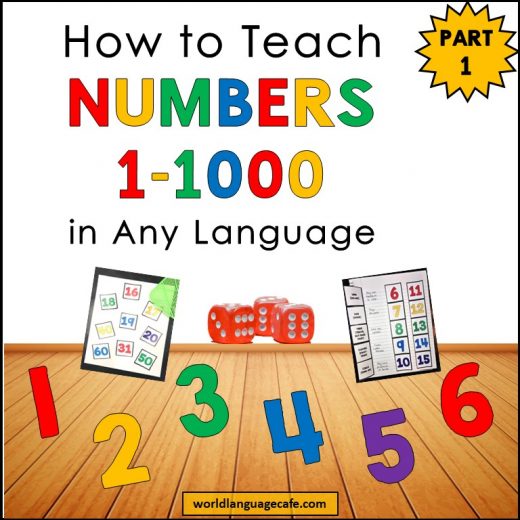Welcome to this blog series about ways to get your students speaking in the target language. Part 1 taught pointers and habits to change to be more successful. Today’s post, Part 2, will teach you 20 ways to get your students speaking in the target language.
20 Strategies to Get Students Speaking
Some of these strategies are my own, but most, I have collected from other World Language teachers who were kind enough to share their best tips.
1. The Clothespin Method
“My students wear clothespins for classroom activities. They hold each other accountable for staying in the target language by taking the clothespin of students that speak English. At the end of the activity, each clothespin is worth 1-2 Class Dojo points.” Variation: Award just 1 point for the top 3 people with the most clothespins. Variation: Award a point to everyone who still has a clothespin and an extra point to the person with the most. If you don’t use Class Dojo, you can count these as participation points or have students save up points for a free homework pass, an extra few points on a quiz, or a pass to pick where they sit in class. ~Gail Tuccillo Gillis
2. Speaking Rubric
Fill out a weekly speaking rubric. Students self-assess for the first few weeks, just holistically, how well they’ve held themselves to staying in the target language and how richly they have been expressing themselves. It’s not graded for the first month or so. Then after they get comfortable with the idea, they continue to self-assess, but the teacher assesses and combines their evaluation with the teacher’s assessment for the speaking portion of their grade. ~Catharyn Crane from Sol Azúcar
3. The One Word Strategy
Write a word on the board at the beginning of the period. Any time you hear ANY English, erase a point. If the class has any letters left over at the end of the period, they each get an extra point on the next test. As they get better, they must keep the word up for a few days or a week. See Angie Torre from Best PowerPoints for Spanish’s blog post explaining more.
4. Don’t Tell Me, Show Me
You must become an actor or actress, master of charades. Angie remarks that 80% of learners are visual learners, so the more visual cues that you can give (photos, charades, etc.), the more comprehensible the input becomes. Here are some more ideas from Angie:
5. Mime Method
Mime what you are saying.
6. Signaling
Point to what you are talking about.
7. Use Gestures
Whenever you’re teaching songs, teach gestures for the keywords before starting and have the students practice them. Say the word and have them do the gesture. Then they do the gestures along with the song.
8. Draw
Draw a picture of what you’re talking about.
9. Use Photos
Print out pictures or photos to illustrate concepts. Tape the target language word or phrase on the photograph.
10. Student Vocabulary
Assign each student a vocabulary word or phrase and have them make a meme to illustrate its meaning. Find a picture online to represent the concept and then add a text box on top with the words.
11. Post Your Instructions Visually
If you’re an elementary school teacher, you might like this blog post about staying 90% in the target language. In it, Julie from Mundo de Pepita suggests posting your instructions visually. For older students, Angie Torre also suggests using a PowerPoint showing the key language that you are using in the target language. When we watch a movie in another language, it’s so much easier to understand if we can read the words while we listen to them. Do this in your class, too. Put key phrases on bulletin boards or on your whiteboard for the day.
12. The Págame System
TPRS guru, Blaine Ray, suggests using a “Págame”. Students start with 100 points each quarter and if they aren’t actively engaged in the target language and participating, the teacher says the student’s name and “Págame” (ex. Luis, págame.). Then the teacher makes a mark next to the student’s name on a list at the front of the class. Students can make up págame’s by writing in the target language. Read more about Blaine Ray’s, (the TPRS guru), Págame System on p. 17 and 18 of this link.
13. Safe English Space
Create a space or time when students can speak to you in English if necessary. Mine was always outside my doorway in the hall before or after class or in my department center (although I always would start speaking the target language and they would need to request to speak in English).
14. The Ticket System
Appoint one student in the group to be the “ticket taker” if they hear English. The winner of the next round gets to be the new “ticket taker.” Get free euro tickets and read more about how Elisabeth Edwards Alvarado from Spanish Mama uses this system here.
15. Pass the Piñata
Have a large object (ex. a piñata) that gets passed to anyone who speaks English. If the person with the piñata hears anyone else speaking English, they can give it to that person. Whoever has the piñata at the end of class gets a small punishment (an extra sheet of homework, has to pick up anything on the classroom floor, etc.) Spanish Mama says there are a few drawbacks: Great in theory, and for specific discussion times, but she usually only remembered it because the students said, “Profe, la piñata! because they wanted to get an unlucky friend in trouble.
16. Teach Circumlocution
Joshua Cabral from World Language Classroom emphasizes the importance of teaching his students’ circumlocution. Here are some of his suggestions that you may wish to post in your classroom: Use vocabulary that you already know. Try to think of another way to convey the message. Describe the concept. Explain who uses it, why it’s used, or where. Use a synonym. Use a more general category word (fruit, clothing, etc.) Explain what the object is and what the object is not. Check out Joshua’s circumlocution resources and a recap of one of his periscopes about using the target language here.
17. Comprehension Checks
Do lots of comprehension checks. Students hold up fingers from 1-5. 5 = they completely understand, 1 = they don’t understand at all. Thumbs up, thumbs down, or a sideways thumb works, too. ~Laura Lee from For the Love of Spanish
18. Secret Student Method
Reward the whole class if a particular (secretly chosen) student is speaking in the target language (or demonstrating whatever other behavior you’d like) on that day. Pick the name beforehand and put it in a box or some other location in class. ~Tammy at FSL Teaching
19. Magic Tissue Box
Create activities that have set pieces that only use the target language. uses a “magic tissue box” and puts questions in the target language inside. The students take turns pulling out a question, sneezing (class responds in the target language to the sneeze (Salud, À tes souhaits, etc), and then the person answers the question. Another person picks a tissue and so on. ~Carolina Goméz from Fun for Spanish Teachers (Read more about it in her blog post).
20. Speaking Rocks
Use decorative pebbles (the kind you find in flower vases) to encourage speaking in the target language. Each student takes 2 rocks when they come into class and must have 5 when they leave class. They earn extra pebbles by participating in the target language. She takes away a pebble when they speak English (without any other verbal reminder). And get this – her students loved it and asked for it the next day!!! ~Holly from Spanish Sundries (Read more here).
Wow! So many ideas from amazing veteran World Language teachers. Try some over the coming weeks to see which ones work best for you.
You may want to read this next part to prepare for when everything doesn’t run quite so smoothly (because we all know there are days like that).
Want ideas for class? Grab 25+ free resources in the Free Resource Library!
Have any more suggestions that I should add to this article?
Email me at worldlanguagecafe@gmail.com.
I’d love to hear your thoughts!
See you in the Teachers’ Lounge soon!





No Comments